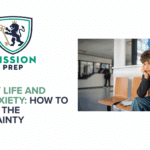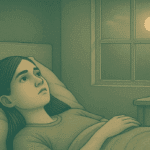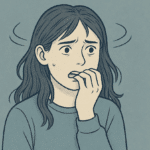Breathwork for Anxiety Relief: Teen Anxiety Breathwork Guide

Anxiety in teens isn’t always obvious. Sometimes, it shows up as stomach aches before school, snapping at a sibling for no reason, or zoning out during conversations. But beneath these reactions is a nervous system working overtime – stuck in a cycle of feeling convinced that something’s going to go wrong, even when it isn’t.
But there’s a simple action anyone can take, anywhere, at any time: breathwork for anxiety relief. Recent research shows that slow, controlled anxiety breathing exercises can measurably lower stress levels and ease symptoms of anxiety.¹
Yet, breathwork isn’t just about “taking deep breaths.” It’s about learning how to access calm from within the body before the anxiety spiral takes over.
This guide explores the following aspects of anxiety breathing exercises:
- How breathwork therapy for youth improves mental health
- The ways breathing impacts the nervous system and eases anxiety
- 5 breathing techniques teens can use to calm anxiety
- How Mission Prep can help with teen mental health

How Breathwork Supports Teen Mental Health
For teens experiencing anxiety, their bodies can often feel like an enemy, especially when they experience a tight chest, racing heart, dizziness, or that sense of being “stuck.” These aren’t imagined symptoms; they’re physiological signs of an overactivated stress response. This is where guided breathwork for teens enters the conversation. Although it can work to quickly calm the body, it’s also a targeted way to rebalance the nervous system for the long run.
Studies show that slow, intentional breathing techniques for stress activate the parasympathetic nervous system and lower heart rate.² This shift moves the brain out of survival mode, helping teens access clearer thinking and emotional flexibility.
Recognition for the benefits of breathing techniques for stress has also become more widespread. For instance, yoga, which includes breathwork therapy for youth, is increasingly being integrated into school-based mental health programs, with evidence suggesting improvements in mood regulation, focus, and even sleep quality.³
So, in a nutshell, mindful breathing for anxiety teaches teens how to calm down in the moment and build long-term emotional resilience, one breath at a time.
Why Breathing Affects Anxiety: The Nervous System Explained
Anxiety doesn’t begin in the mind. It begins in the body, and more specifically, in the nervous system’s perception of threat. For teens, whose brains are still developing core pathways for emotion regulation, the constant sense of threat can feel overwhelming and hard to interrupt.⁴
At the center of this stress response is the autonomic nervous system, which has two primary branches:
- The sympathetic nervous system: This is responsible for activating someone’s fight, flight, or freeze response.
- The parasympathetic nervous system: This governs someone’s rest and recovery state, often called “rest and digest.”
When anxiety strikes, the sympathetic system floods the body with adrenaline, increasing heart rate, tightening the chest, and often leading to rapid, shallow breathing.⁵ In this state, the brain’s threat detection center becomes hyperactive, while the area responsible for reasoning and decision-making begins to go offline.⁶
This is where the vagus nerve plays a vital role. As the longest nerve in the body, the vagus nerve directly communicates between the brain and the major organs.⁷
This nerve serves as the primary regulator of the parasympathetic nervous system. Intentional breathing, especially diaphragmatic breathing for anxiety, stimulates the vagus nerve, sending a signal of safety that helps downshift the nervous system out of crisis mode.
Research has also shown that controlled breathwork can reduce brain activity linked to overthinking and rumination.⁸,⁹ As teens’ abilities to regulate thoughts and actions are still maturing, this can offer a crucial foothold when managing anxious loops.
Studies have found a relationship between nasal stimulation and brain activity.¹⁰ In other words, breath control for teenage anxiety isn’t just a relaxation tool. It’s a direct neurological intervention. By shifting the body’s internal state, teens regain access to clearer thoughts, emotional regulation, and a greater sense of control in the moment.
5 Effective Breathing Techniques to Calm Anxiety in Teens
Teens have several options for breathing exercises to calm down and feel more grounded, including:
Box Breathing for Anxiety
Box breathing, sometimes even taught to Navy SEALs for calming under pressure, is one of the most effective and accessible tools for teen anxiety. It’s especially helpful when a teen feels panicked, overwhelmed in class, or emotionally flooded after a difficult interaction and uses a simple four-part rhythm:¹¹
- Inhale for 4 seconds
- Hold for 4
- Exhale for 4
- Hold for 4
- Repeat this cycle 4–6 times.
Box breathing interrupts the body’s stress response cycle by helping the autonomic nervous system shift from sympathetic (fight or flight) into parasympathetic (rest and digest) mode.
Each breath cycle gently stimulates the vagus nerve, lowering heart rate and blood pressure, and signaling to the brain that the environment is safe. The technique also re-engages the part of the brain that allows teens to think clearly, weigh options, and access emotional regulation.¹²
Diaphragmatic Breathing for Anxiety
Also called “belly breathing,” diaphragmatic breathing teaches teens how to draw air deeper into their lungs by activating the diaphragm, a dome-shaped muscle beneath the rib cage.¹³ Unlike anxious chest breathing, which is shallow and fast, this method slows everything down.
By stimulating the vagus nerve, diaphragmatic breathing sends calming messages from the body to the brain. It reduces levels of cortisol, the body’s primary stress hormone, while improving oxygen delivery to the brain and muscles.
To practice diaphragmatic breathing for anxiety, place one hand on the chest and the other on the stomach. Inhale slowly through the nose for about 4–6 seconds. The belly should rise while the chest stays mostly still.
Then, exhale slowly through the mouth for 6–8 seconds, allowing the belly to fall. Repeat for a few minutes, focusing on the movement of the lower hand.
Research shows that even five minutes of diaphragmatic breathing can significantly lower blood pressure and perceived stress levels.¹⁴,¹⁵ Over time, practicing this technique can improve emotional awareness and reduce the frequency of panic attacks or anxiety spirals in teens.
4-7-8 Breathing
This technique uses a longer exhale to guide the nervous system back to a calm state. It’s often taught as a sleep aid, but it also works in moments of emotional intensity, especially when anxiety shows up as racing thoughts or restlessness.¹⁶
The extended exhale is what helps calm the body down. When the exhale is longer than the inhale, it signals the parasympathetic nervous system to engage. This slows the heart rate, reduces blood pressure, and makes space for calm. It also teaches teens how to tolerate emotional buildup without reacting, which is essential for rewiring anxious patterns.
To practice 4-7-8 breathing, inhale through the nose for 4 seconds. Hold for 7 seconds and then exhale slowly through the mouth for 8 seconds. Repeat for 4–6 cycles.
Breath Counting
Breath counting isn’t about controlling the breath, but about observing it. When practicing the technique, teens breathe normally but count each exhale, starting at one and going up to ten. If the mind wanders, they gently begin again at one.
This exercise strengthens the ability to regulate attention, emotion, and impulse control. It also reduces overactivity to manage worry and rumination. Studies have shown that breath counting can lead to more awareness, better mood, increased internal control, and less mind wandering.¹⁷
For teens who find meditation intimidating or “boring,” breath counting offers a focus point that feels achievable. And because it’s quiet and internal, it can be used anywhere, like on the bus, in class, or during a wave of panic.
Alternate Nostril Breathing
Alternate nostril breathing is an ancient yogic practice, as gently shifting air from one nostril to the other can bring a sense of calm. Studies show that the technique stabilizes stress levels, brainwave patterns, and leads to improved emotional regulation and cognitive performance.¹⁸,¹⁹
Alternate nostril breathing also allows internal rhythms (like breath, heartbeat, and thought speed) to work in line with each other, reducing anxious reactivity.²⁰
To practice this breathing technique, block your right nostril (for instance, by using your thumb) and take a slow breath in through the left. Then, switch to close the left nostril and slowly release the air from the right one. Repeat this for 1-4 minutes, or until you feel more relaxed.
Guided Breathwork and Meditation Practices for Teens
Not every teen can easily use breathwork without guidance, and this isn’t a failure of discipline. In fact, during intense anxiety, self-guided breathing can feel frustrating or even impossible. However, guided breathwork offers something different: a calm, external anchor that helps the body regulate before the mind catches up. It helps calm the mind and body by activating certain parts of the brain that tend to underfunction during self-led exercises.²¹
Different guided formats serve different needs. For example:
- Body scan and breathwork practices help teens reconnect with sensation, which is useful for those who dissociate, shut down, or live in their heads.
- Imagery-based breathing, like visualizing a wave or glowing light, can extend the breath cycle and support emotional grounding through sensory imagination.
- Box breathing with affirmations pairs breath pacing with short, neutral statements like “I am here” or “This will pass,” reinforcing emotional safety through repetition.
Neuroscience also shows us that pairing slow breathing with calming vocal input reduces the reactivity of the brain’s threat detection center. It also regulates heart rate and improves the brain’s ability to notice what’s going on inside the body.
At Mission Prep, our therapists can help teens with guided therapy and breathwork.
Tips for Building a Breath Practice Teens Can Stick With
Building a habit around breathwork isn’t about maintaining strict discipline. It’s about creating an accessible, familiar routine in which calm starts to become a teen’s go-to state. The following tips may help:
- Keep it short at first: Two to three minutes is enough to begin with. Consistency matters more than length
- Pair it with routine: Tie breathwork to something already familiar, like brushing teeth, showering, or putting on headphones
- Use tech strategically: Apps like Insight Timer or UCLA Mindful can offer variety and structure without overwhelm
- Allow it to be self-guided: While some teens prefer to work through their anxiety in silence, others might benefit from music, visuals, or a specific voice. Providing options is important
- Track how it feels: Invite reflection on how things feel instead of simply checking a box
- Normalize restarts: Missing a day (or week) doesn’t mean failure. The brain learns through repetition, and it’s never too late to start from scratch again
- Model it when possible: Teens co-regulate with adults. If they see you breathe through stress, they’ll internalize that it works

Reach Out to Mission Prep for Help with Breathwork Therapy for Youth
Breathwork for anxiety relief can be helpful in day-to-day life, but when anxiety becomes persistent, added support often makes a difference. At Mission Prep, we guide teens through tailored approaches that calm both body and mind.
Our team of professionals uses strategies like guided breathwork, diaphragmatic breathing, breathwork for panic attacks, and co-regulation to help ease stress and improve emotional regulation. Each teen’s nervous system is different, so we adapt our approach to meet their specific needs. We can also combine these anxiety breathing exercises with therapy options, maximizing their outcomes for the future.
To learn how breathwork therapy can support your teen’s mental health or learn more about treatment options for anxious teens, reach out to our compassionate team.
References
- Örün, D., Karaca, S., & Arıkan, Ş. (2021). The effect of breathing exercise on stress hormones. Cyprus Journal of Medical Sciences, 6(1), 22–27. https://cyprusjmedsci.com/articles/the-effect-of-breathing-exercise-on-stress-hormones/cjms.2021.2020.2390
- Russo, M. A., Santarelli, D. M., & O’Rourke, D. (2017). The physiological effects of slow breathing in the healthy human. Breathe, 13(4), 298–309. https://pmc.ncbi.nlm.nih.gov/articles/PMC5709795/
- Sumner, A. L., Cartwright, T., Ballieux, H., & Edginton, T. (2025). School-based yoga and mindfulness interventions for young adolescents: A qualitative study in a disadvantaged area. British Journal of Health Psychology, 30(2), e12793. https://pmc.ncbi.nlm.nih.gov/articles/PMC11920380/
- Xie, S., Zhang, X., Cheng, W., & Yang, Z. (2021). Adolescent anxiety disorders and the developing brain: Comparing neuroimaging findings in adolescents and adults. General Psychiatry, 34(4), e100411. https://pmc.ncbi.nlm.nih.gov/articles/PMC8340272/
- Chu, B., Marwaha, K., Sanvictores, T., Awosika, A. O., & Ayers, D. (2025). Physiology, stress reaction. In StatPearls. StatPearls Publishing. https://www.ncbi.nlm.nih.gov/books/NBK541120/
- Kenwood, M. M., Kalin, N. H., & Barbas, H. (2022). The prefrontal cortex, pathological anxiety, and anxiety disorders. Neuropsychopharmacology, 47(1), 260–275. https://pmc.ncbi.nlm.nih.gov/articles/PMC8617307/
- Kenny, B. J., & Bordoni, B. (2025). Neuroanatomy, cranial nerve 10 (Vagus Nerve). In StatPearls. StatPearls Publishing. https://www.ncbi.nlm.nih.gov/books/NBK537171/
- Salimi, M., Ayene, F., Parsazadegan, T., Nazari, M., Jamali, Y., & Raoufy, M. R. (2023). Nasal airflow promotes default mode network activity. Respiratory Physiology & Neurobiology, 307, 103981. https://www.sciencedirect.com/science/article/abs/pii/S1569904822001409
- Chou, T., Deckersbach, T., Dougherty, D. D., & Hooley, J. M. (2023). The default mode network and rumination in individuals at risk for depression. Social Cognitive and Affective Neuroscience, 18(1). https://pmc.ncbi.nlm.nih.gov/articles/PMC10634292/
- Zaccaro, A., Piarulli, A., Laurino, M., Garbella, E., Menicucci, D., Neri, B., & Gemignani, A. (2018). How breath-control can change your life: A systematic review on psycho-physiological correlates of slow breathing. Frontiers in Human Neuroscience, 12, 353. https://pmc.ncbi.nlm.nih.gov/articles/PMC6137615/
- Kumar, K. (2021, November 18). Why do Navy SEALs use box breathing? MedicineNet. https://www.medicinenet.com/why_do_navy_seals_use_box_breathing/article.htm
- Balban, M. Y., Neri, E., Kogon, M. M., Weed, L., Nouriani, B., Jo, B., Holl, G., Zeitzer, J. M., Spiegel, D., & Huberman, A. D. (2023). Brief structured respiration practices enhance mood and reduce physiological arousal. Cell Reports Medicine, 4(1), 100895. https://pmc.ncbi.nlm.nih.gov/articles/PMC9873947/
- Ma, X., Yue, Z.-Q., Gong, Z.-Q., Zhang, H., Duan, N.-Y., Shi, Y.-T., Wei, G.-X., & Li, Y.-F. (2017). The effect of diaphragmatic breathing on attention, negative affect and stress in healthy adults. Frontiers in Psychology, 8, 874. https://www.frontiersin.org/journals/psychology/articles/10.3389/fpsyg.2017.00874/full
- Hamasaki, H. (2020). Effects of diaphragmatic breathing on health: A narrative review. Medicines, 7(10), 65. https://pmc.ncbi.nlm.nih.gov/articles/PMC7602530/
- Yau, K. K.-Y., & Loke, A. Y. (2021). Effects of diaphragmatic deep breathing exercises on prehypertensive or hypertensive adults: A literature review. Complementary Therapies in Clinical Practice, 43, 101315. https://pubmed.ncbi.nlm.nih.gov/33530033/
- Fletcher, J. (2019, February 12). 4-7-8 breathing: How it works, benefits, and uses. Medical News Today. https://www.medicalnewstoday.com/articles/324417
- Levinson, D. B., Stoll, E. L., Kindy, S. D., Merry, H. L., & Davidson, R. J. (2014). A mind you can count on: Validating breath counting as a behavioral measure of mindfulness. Frontiers in Psychology, 5, 1202. https://www.frontiersin.org/journals/psychology/articles/10.3389/fpsyg.2014.01202/full
- Sinha, A. N., Deepak, D., & Gusain, V. S. (2013). Assessment of the effects of pranayama/alternate nostril breathing on the parasympathetic nervous system in young adults. Journal of Clinical and Diagnostic Research, 7(5), 821–823. https://pmc.ncbi.nlm.nih.gov/articles/PMC3681046/
- Stancák, A., Jr., & Kuna, M. (1994). EEG changes during forced alternate nostril breathing. International Journal of Psychophysiology, 18(1), 75–79. https://pubmed.ncbi.nlm.nih.gov/7876041/
- ClinicalTrials.gov. (n.d.). Study record detail: Alternate nostril breathing. Retrieved July 10, 2025, from https://www.clinicaltrials.gov/study/NCT04674865?term=AREA%5BBasicSearch%5D(%22alternate%20nostril%20breathing%22)&rank=3
- Clauss, J. A., Benningfield, M. M., Rao, U., & Blackford, J. U. (2016). Altered prefrontal cortex function marks heightened anxiety risk in children. Journal of the American Academy of Child and Adolescent Psychiatry, 55(9), 809–816. https://pmc.ncbi.nlm.nih.gov/articles/PMC5003319/



















